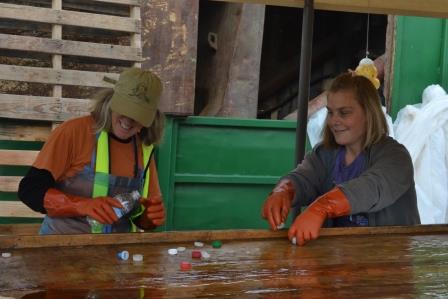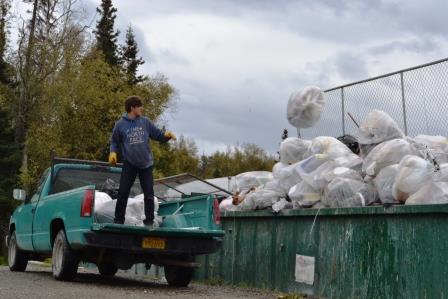
Home > Dispatches > Daily Dispatches 2017 >Daily Dispatch #231
August 24, 2017: Fair Enough
I have a new job. I’m an Alaska State Fair Recycling Sorting Area supervisor. My work hours for the next few weeks will be from 4 p.m. to 10 p.m. My husband Pete suggested that I take on this temporary job, adding that this would put a dent in our hay bill. We have four horses, three chickens, two goats, one dog, and all have good appetites. I agreed, and so here I am. I’m working with volunteers. I tell them what their job entails – essentially, they are to take a wagon, go out into the fairground area, then, with grabbers in hand, pull plastic bottles and aluminum cans out of green barrels with matching lids and drop the recyclables into large white bags. They’re also to locate cardboard, flatten it, and place it in their cart. Upon their return they can elect to either go out on yet another run, or assist in sorting out and bagging the collected materials. The bags are emptied onto a long table that I think used to be used for gutting fish. Number One plastic bottles go into one garbage can, and aluminum cans into another. The caps and other non-recyclable garbage go into the regular garbage can. The one in charge at the table empties the five-gallon gray water bucket into a larger garbage can, which is later emptied by a |
|
| company that cleans out the portable toilets. And the garbage cans containing the bottles and cans are emptied into large super sacks on frames. When full, the sacks are transferred into two roll off garbage containers. The roll offs are taken to VCRS where the material will be baled and then shipped to the Lower 48. The sorting area is conveniently located at the edge of the Orange Area parking lot. The Lumberjack area and Raven Hall are within sight. Three dark green dumpsters are located adjacent to the sorting area. One contains cardboard and two contains non-recyclable waste. Some of the waste is generated by the vendors, the rest by fairgoers. The maintenance workers routinely remove the white bags from the red barrels and insert new ones. The full white bags are then tossed into the two side-by-side dumpsters. You’d think that orchestrating the above would be easy. It’s not. There are, I am learning, innumerable details to tend to in the above seemingly simple process. In fact, there are so many details that I’ve already determined that I need to take short breaks so that I can figure out how to explain particulars to newcomers. I headed over to the two garbage dumpsters on my first time-out and assessed the situation. There was cardboard in there, lots of cardboard. That which was on top of the full white bags was accessible. And that which was under the bags was inaccessible. I yanked some of the assessible pieces off the top and ran them over to the cardboard dumpster, and flung them on the growing pile. As for the inaccessible pieces – I considered climbing in the dumpster and rooting around. There was a time in my life when I would have climbed in without considering the consequences of my actions. Ahh, but a now older and wiser me took a moment to assess the situation. Once in, how would I get out? And in addition, I didn’t have a change of clothes on me. I didn’t want to spend the rest of the day covered in corn oil and mayonnaise. A girl’s gotta do what a girl’s gotta do. I pushed aside some of the lighter white plastic bags, grabbed some flattened cardboard corn boxes, and ran them over to dumpster. I could not reach a perfectly good five-gallon bucket. But I managed to salvage a box of sandwich bags. It was as I plucked a sodden Gyros box out of the mess that a new reason for my taking on this job came to the forefront of my consciousness. Yes, I do have a hay bill. But more importantly, there is the matter of all this waste and where it goes. Our local landfill is filling up. The area that surrounds it is currently being used for recreational purposes by bicyclists, horseback riders, skiers, and hikers. Once the cells (as they are called) are opened up, the land as we know it will cease to be. VCRS is located within hearing distance of the Palmer Landfill. In fact, they are both located off the same road. So we consumers have a choice. We can go straight down the road to the Landfill entrance, pay a fee and dump our load in its entirety. Or we can take a right and leave our sorted recyclables at VCRS. My being here, I can directly and indirectly reduce the amount of waste going to the landfill. This is a task that I now relish. |
|

